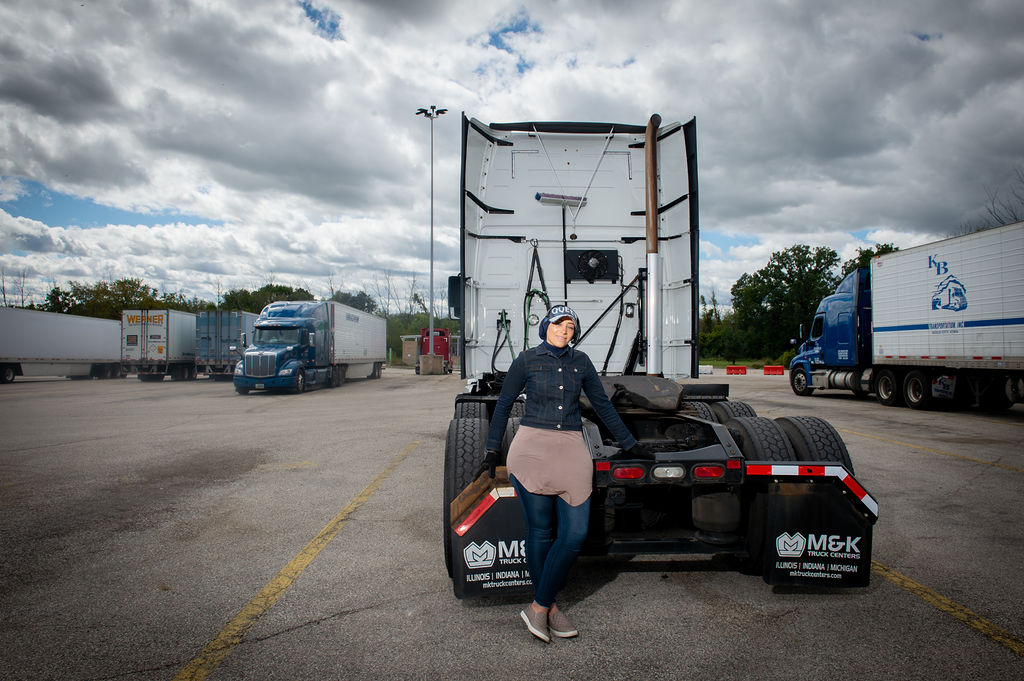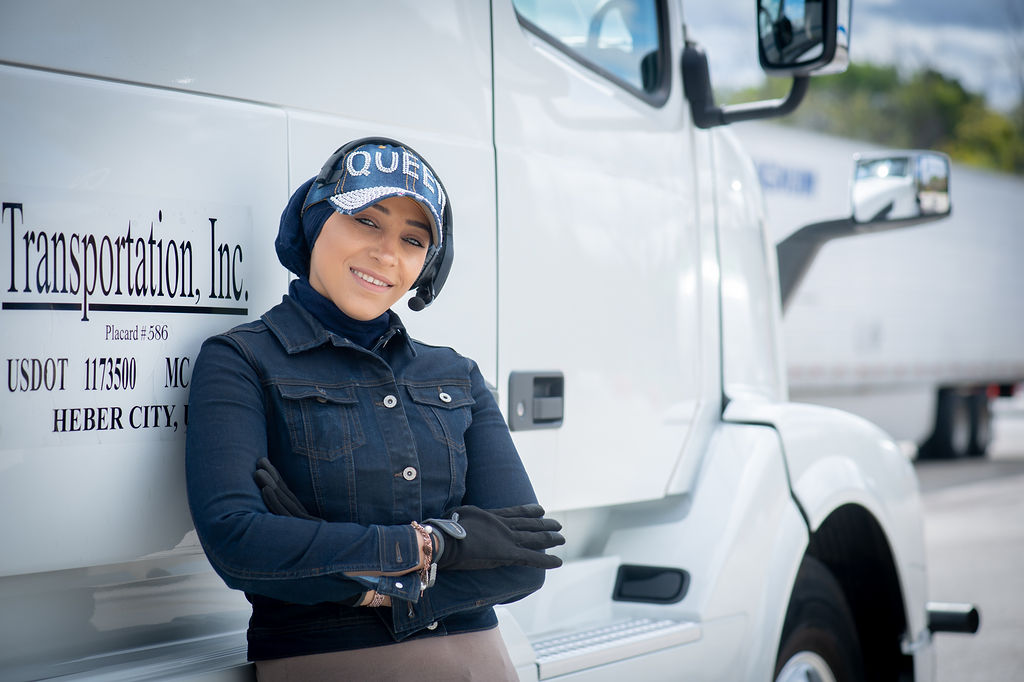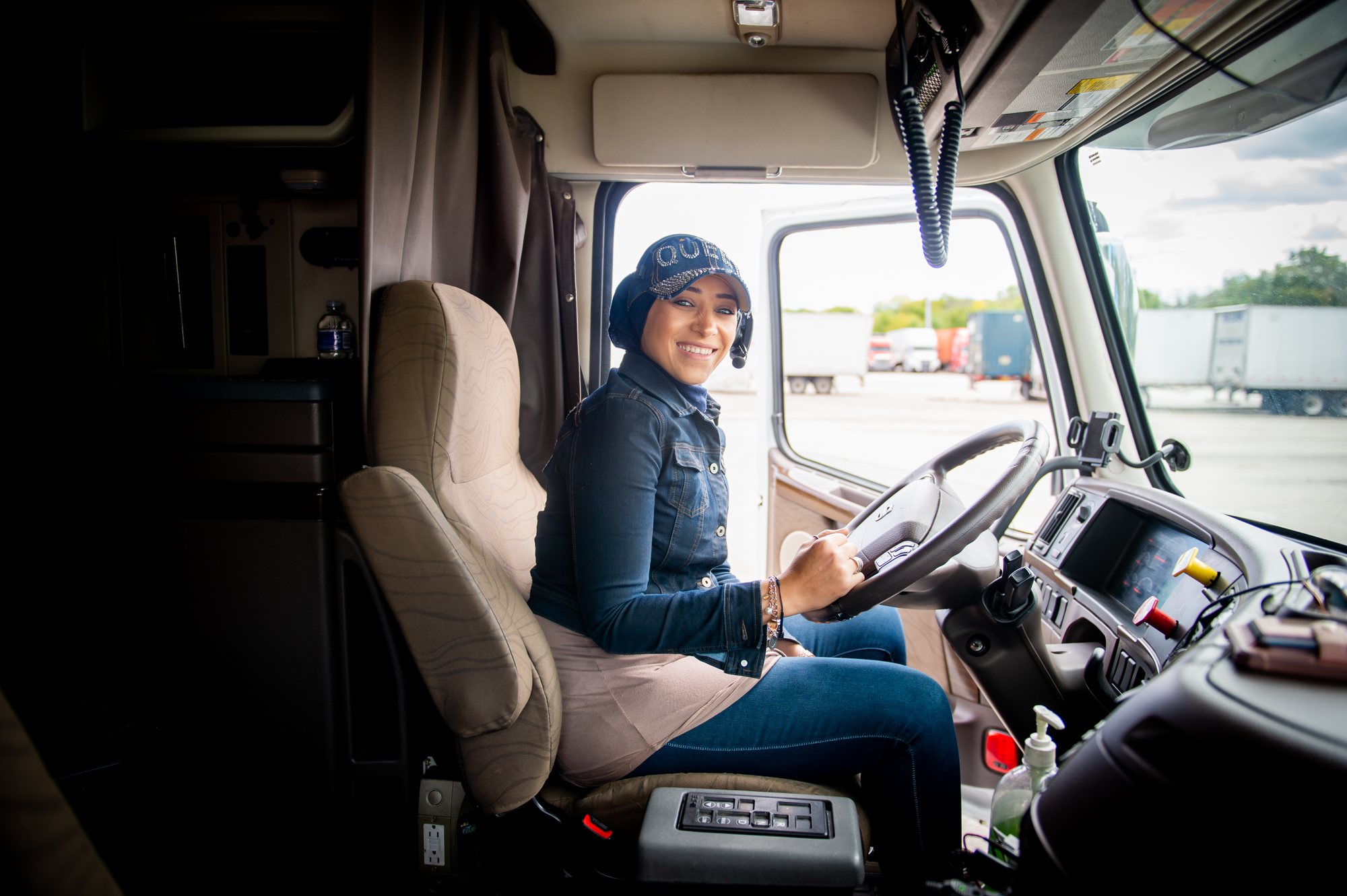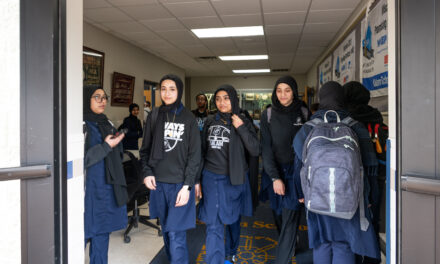Mouna Photography
Wearing a headset and a cap that says “Queen” in spangles, Maysa Abu Khdair, 34, looks more like a deejay or the employee of a trendy boutique than a semi-truck driver. But driving a big rig is what she does for a living, a job that she describes as her “passion.”
Abu Khdair, who has been a semi driver for two years, claims driving a semi is “not hard, as long as you love it and you’re capable. I love trucks.”
Today, Abu Khdair is one of 3.5 million professional truck drivers in the U.S., the vast majority of them men. Only 7.89 percent of truck drivers are women, according to the Women in Trucking Association, whose goal is “bringing gender diversity to transportation.”
However, Abu Khdair seems to have no qualms about working in such a male-dominated profession. “Whatever they [male drivers] do, we can do it. There are a lot of good ladies on the road. Better than the men.”
A Palestinian native from Jerusalem, Abu Khdair describes herself a trucking family. Her father and four brothers are truck drivers, though her sisters have more traditional female occupations, like fashion designer, teacher, cosmetologist.
Abu Khdair, who is the mother of three children, ranging in age from 15 to 9, came to the United States with her ex-husband in 2004. She currently lives in Greendale. Abu Khdair earned an associate’s degree in business from MATC and was working as a customer service representative in a clinic when she decided to follow her heart and go into trucking.
She enrolled at 160 Driving Academy in Oak Creek and took the CDL (commercial drivers license) program. The school, which also has locations in Illinois, provides trucker training and HazMat certifications.
As a long-haul truck driver, Abu Khdair said proudly that she has visited 39 states. But today she makes regional runs, driving a truck owned by Sam Shalakhti, an owner-operator based in Illinois. Her dispatch is handled by Transportation, Inc. A typical day might have her picking up a load and driving it to Green Bay or Detroit, then driving back down to Chicago with another load. “I get a call from my dispatch, pick up a container, and drop it to a yard,” Abu Khdair said. “You work 60 hours for the week and then reset,” she said.


The new white Volvo that Abu Khdair drives is called a “bobtail,” what the uninitiated would call the cab of a truck. Loads are attached via the drop-and-hook in back, which hooks the trailer to the bobtail. Some truckers drive flatbeds with shipping containers loaded onto them. Some drive tankers. Abu Khdair’s bobtail has an engine big enough to haul 28 ft., 48 ft., or 53 ft. trailers. The last one makes “a really wide turn,” Abu Khdair says. But she thinks the 28 ft. is harder to back up, because it’s “very fast, wiggling like a snake,” and requires the driver to make “small adjustments.”
According to Popular Mechanics, it takes a big engine to move the weight bobtails haul.
A large SUV might have a 200 hp (horsepower) engine, while the engine of a small car has 70 hp.
Have you ever seen a sign along the highway that said, “No Engine Braking” and wondered what that could possibly mean? Abu Khdair said that a semi’s engine brakes can be very noisy, so engine braking is banned near residential areas. Most trucks are equipped with hydraulic or “engine” brakes that give the truck “more power to stop,” she said, but they are secondary to the airbrake system for slowing or stopping a moving truck. But, Abu Khdair warns, “going downhill using airbrakes, if you keep braking too much, they will start smoking.”
And while it may not take man-sized muscle to drive a truck, it does take skill. “A lot of it is learning how to manage the docks,” Abu Khdair said. “That’s why a lot of companies want between 2 to and 5-years’ experience for local jobs. And they want drivers who know how to maneuver the truck” at a loading dock. This is one of the ways that women drivers are sometimes underestimated. Abu Khdair once helped a male driver who couldn’t get his truck backed up to the dock. She jumped behind the wheel and backed it up for him. A couple of male drivers came up to her afterward and said, “You were very nice to help him,” she said.
The CB radio is still the trucker’s friend while driving on the granny (righthand lane on the freeway), the sandwich (middle lane) or the hammer (left lane). Drivers get on the CB and warn each other of upcoming traffic snarls, which lane to get into or stay out of, and whether there are “bears” (highway patrol) around, said Abu Khdair, who clearly enjoys the camaraderie of trucking.

Abu Khdair met her friend Sherra Vinson at 160 Driving Academy. When I reached Vinson, 44, she was in Fargo, North Dakota for a driver-appreciation golf tournament sponsored by her company, Magnum, Ltd. Before Vinson began driving two years ago, she did, “some of everything,” including IT. Asked how she likes being a truck driver, she said, “I love it, actually.”
Vinson, a member of Black Truck Drivers Only, said that, “Overall, we all know trucking is dangerous” and it may be “a little more dangerous” for women than for men. “There are some creeps out there who will follow you around the truck stop,” Vinson said. And she worries about people who have been shooting at trucks on the freeway. “But that’s just random,” she said.
Vinson describes Abu Khdair as “a very sweet person” who is “very determined,” and says, “I’m so proud of her for what she’s achieved so far.” Abu Khdair “learned quickly and handles her business,” Vinson said.
Unlike Abu Khdair, Vinson is a long-haul driver. “I live in my truck and stay out on the road all the time,” she said. The isolation of long-haul driving can be a problem for some people, but Vinson said, “I enjoy being by myself.” And, she said, “I don’t have to pay rent or utilities.”
The typical bobtail is a home away from home. Abu Khdair’s has a table in back where she can eat lunch on her break. If she wants to take a nap, she can replace the table with a fold-down cot. The cab is equipped with a flatscreen TV, a microwave, and a curtain that can be unfolded across the windshield to block those bright truck stop lights.
When she’s not driving, Abu Khdair parks the bobtail at a truck stop like Pilot Travel Center off Ryan Road in Oak Creek. Love’s, another well-known truck stop, is across the street. Semis are parked everywhere, some with the windows shuttered to indicate the drivers are asleep. Many truckers prefer to drive at night, when there are fewer “4-wheelers” on the road, pulling crazy stunts like trying to pass a semi on the right.
Abu Khdair has some words of advice for all of us 4-wheelers. Pass on the left. A truck driver has a very hard time seeing you if you’re creeping up on her right. And remember, no sudden stopping in front of a big truck. If there is an emergency, use your emergency lights, “which will give us time to slow down and notify the other truckers behind us,” Abu Khdair said.














